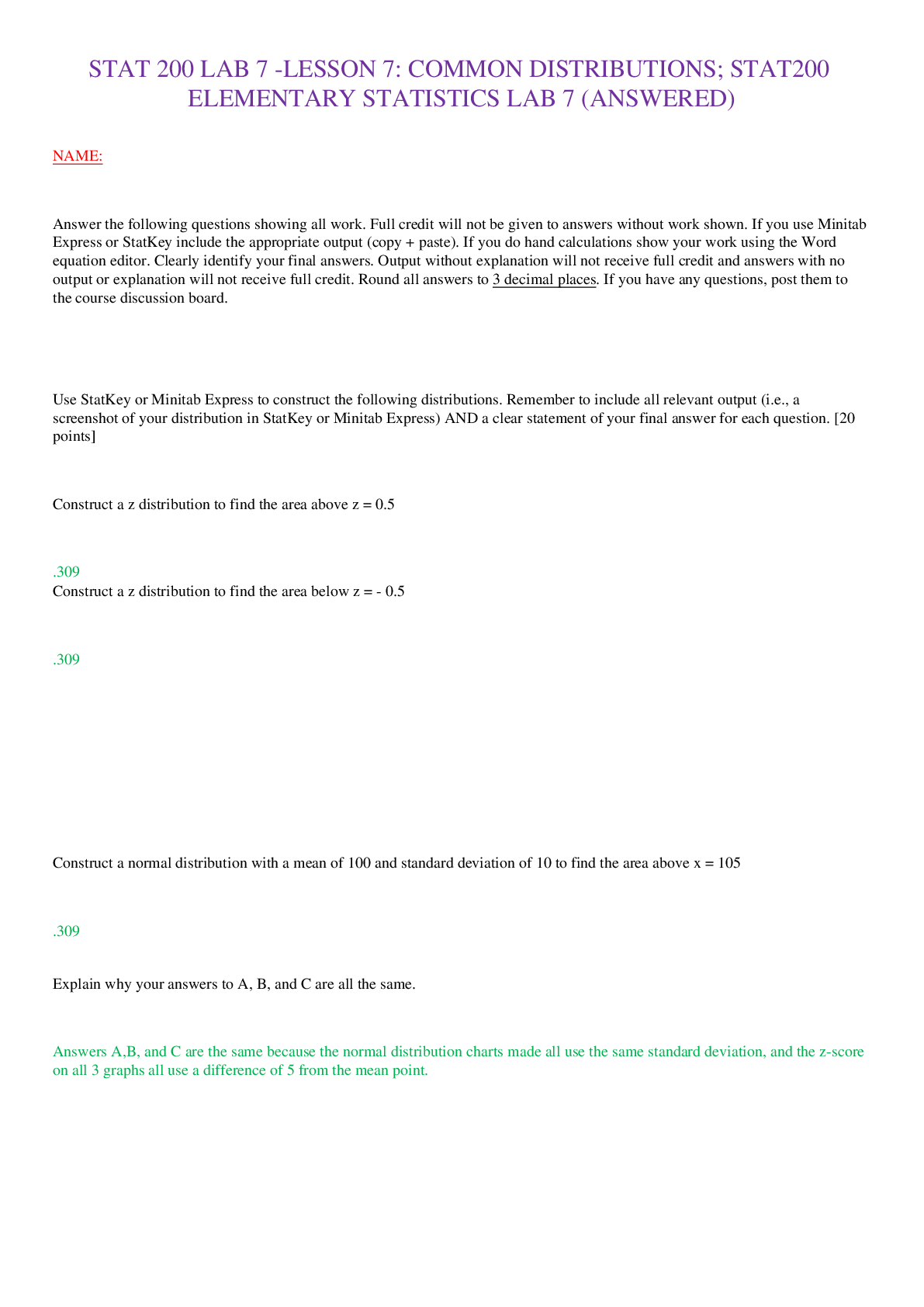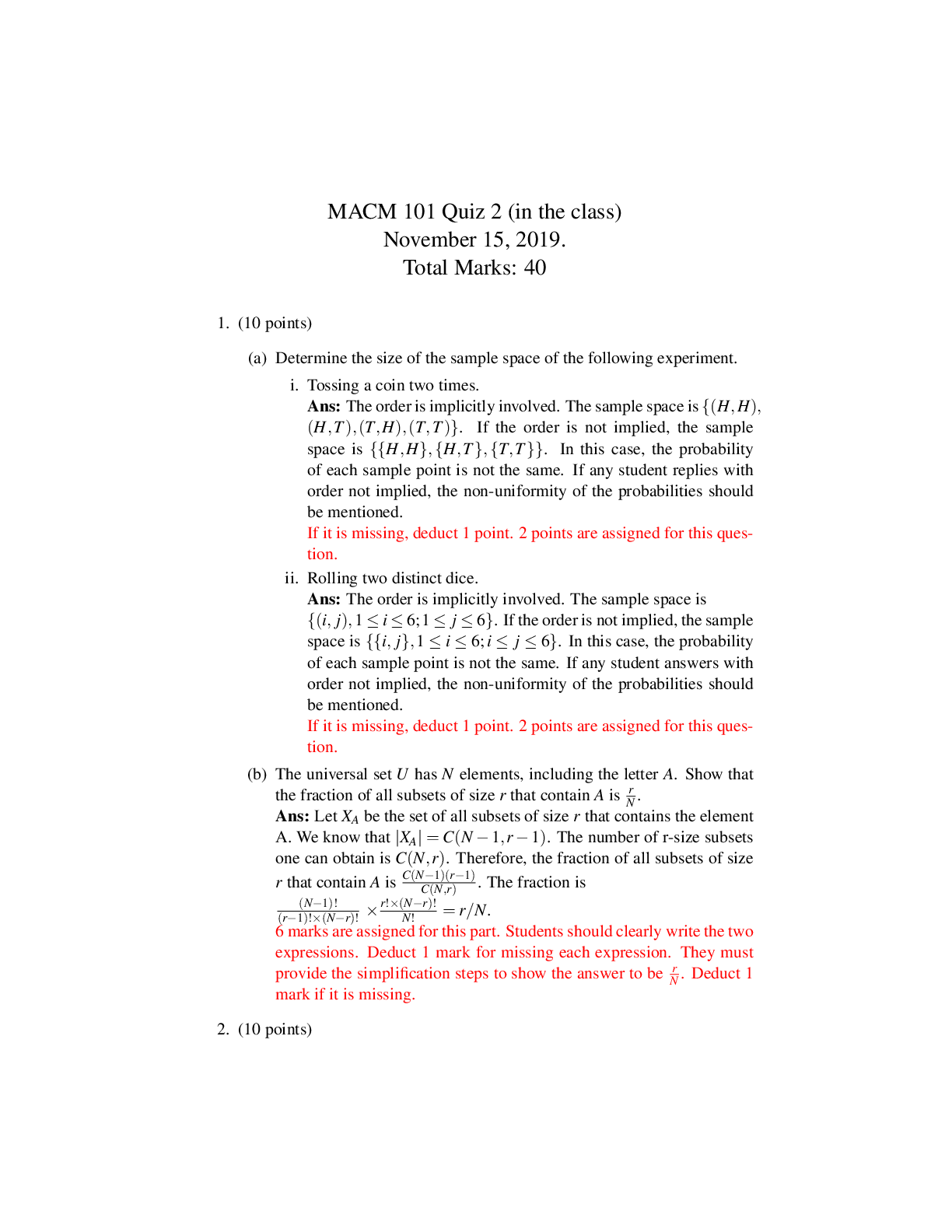Statistics > EXAM > STAT 200 LAB 7 LESSON 7 COMMON DISTRIBUTIONS; STAT200 ELEMENTARY STATISTICS LAB 7 (ANSWERED) (All)
STAT 200 LAB 7 LESSON 7 COMMON DISTRIBUTIONS; STAT200 ELEMENTARY STATISTICS LAB 7 (ANSWERED)
Document Content and Description Below
STAT 200 LAB 7 LESSON 7 COMMON DISTRIBUTIONS; STAT200 ELEMENTARY STATISTICS LAB 7 (ANSWERED) STAT 200 LAB 7 -LESSON 7: COMMON DISTRIBUTIONS; STAT200 ELEMENTARY STATISTICS LAB 7 (ANSWERED) NAME... : Answer the following questions showing all work. Full credit will not be given to answers without work shown. If you use Minitab Express or StatKey include the appropriate output (copy + paste). If you do hand calculations show your work using the Word equation editor. Clearly identify your final answers. Output without explanation will not receive full credit and answers with no output or explanation will not receive full credit. Round all answers to 3 decimal places. If you have any questions, post them to the course discussion board. 1. Use StatKey or Minitab Express to construct the following distributions. Remember to include all relevant output (i.e., a screenshot of your distribution in StatKey or Minitab Express) AND a clear statement of your final answer for each question. [20 points] A. Construct a z distribution to find the area above z = 0.5 .309 B. Construct a z distribution to find the area below z = - 0.5 .309 C. Construct a normal distribution with a mean of 100 and standard deviation of 10 to find the area above x = 105 .309 D. Explain why your answers to A, B, and C are all the same. Answers A,B, and C are the same because the normal distribution charts made all use the same standard deviation, and the z-score on all 3 graphs all use a difference of 5 from the mean point. 2. We want to test the alternative hypothesis that p > 0.60 using a sample of n=200. In that sample of 200, there were 133 successes. [45 points] Hint: Your answers for parts A, D, and F should be very similar. A. Use StatKey to conduct a randomization test. If you need a review, see Lesson 5. Step 1: Determine what type of test you need to conduct and write the hypotheses. Randomization Test for a Proportion Step 2: Construct a randomization distribution under the assumption that the null hypothesis is true. Take at least 5000 resamples. Step 3: Use the randomization distribution to find the p-value. .0022 Step 4: Decide if you should reject or fail to reject the null hypothesis. Reject the null hypothesis Step 5: State a real-world conclusion in relation to the original research question. B. Describe the shape of your randomization distribution. The randomization distribution has a normal bell-shaped curve or a normal distribution C. From your randomization distribution, what is the standard error? .035 D. Model the randomization distribution with a normal distribution. To do this you will construct a normal distribution with a mean of 0.60 (null parameter) and standard deviation equal to this standard error that from part C. Find the p-value by finding the area to the right of the observed sample proportion in this normal distribution. Include a screenshot of your distribution here and clearly identify your p-value. p-value = .025 E. Compute the standardized test statistic using the formula for the general form of a test statistic. Use the standard error from part C. test statistic =.669−.60 =1.97 .035 F. Construct a z distribution (i.e., standard normal distribution) to find the area to the right of the test statistic in part E; this is the p-value. Include a screenshot of your distribution here and clearly identify your p-value. .024 G. Different methods were used in parts A, D, and F, yet the p-values were all similar. Explain why these p-values are all similar even though different methods were used. Even though different methods were used parts A, D, and F were similar due to the normal distribution being used and the standard deviation not changing much. 3. At the beginning of the Summer 2018 semester, a sample of 266 World Campus students were surveyed and asked if they were a first-generation college student. In the sample of 266, 139 said that they were first generation college students. We want to construct a 90% confidence interval to estimate the proportion of all World Campus students who are first generation students. [20 points] Hint: Your answers in parts A and C should be very similar. [Show More]
Last updated: 2 years ago
Preview 1 out of 4 pages

Buy this document to get the full access instantly
Instant Download Access after purchase
Buy NowInstant download
We Accept:

Reviews( 0 )
$10.00
Can't find what you want? Try our AI powered Search
Document information
Connected school, study & course
About the document
Uploaded On
Nov 22, 2022
Number of pages
4
Written in
Additional information
This document has been written for:
Uploaded
Nov 22, 2022
Downloads
0
Views
74














